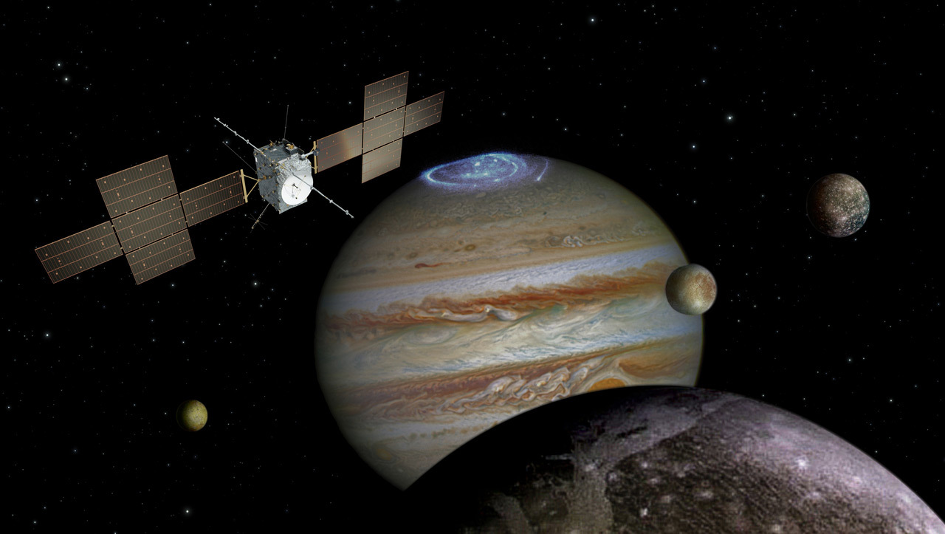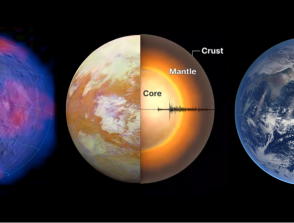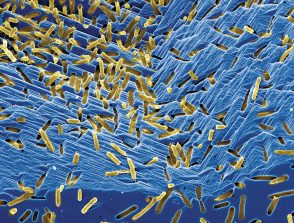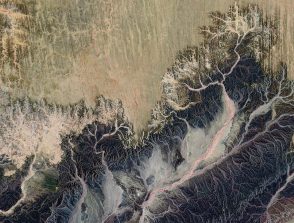APR CNES: Development of super-resolution mapping methods for Icy moons: Applications to Titan and future observations of Ganymede and Callisto by ESA’s JUICE mission

Artist's concept of JUICE spacecraft at Jupiter.
Start: 01/01/2020
National partnership
Coordinators : Sébastien Rodriguez
Host institutions :
IPGP
Partner institutions :
LPGN, IAS, ESAC
Related teams :
Planetology and Space Sciences
Related themes :
Origins, Earth System Science
Preparing the forthcoming JUICE mission by benefiting from super-resolution mapping methods developed for Cassini/Huygens data.
JUICE mission aims to study the Jupiter system and the possible existence of habitable environments. In a similar way to Cassini, the payload of JUICE will include both a high-resolution camera (JANUS) and a hyperspectral imaging spectrometer (MAJIS). JUICE will be the third exploration mission entirely dedicated to the Jupiter system and the first to focus on the icy Galilean moons which are believed to harbor subsurface oceans of liquid water. Scheduled for launch in 2023 and insertion into Jovian orbit in 2031, the probe will perform several flybys of three of Jupiter’s largest moons, namely Callisto (21 targeted flybys), Europa (2) and Ganymede (12). It will then orbit Ganymede for further study, which will be completed in 2034. The Ganymede orbital phase starts with an elliptical phase followed by high-altitude circular orbit (5,000 km). Another elliptical phase will lead to a medium-altitude circular orbit (500 km) and a final low-altitude circular orbit (200 km).
These different conditions of observation present a major challenge when it comes to reconcile the entire dataset for one specific instrument in a first step and for several instruments in a second step (e.g. JANUS and MAJIS). Indeed, the combined acquisition of high-resolution images by JANUS and hyperspectral cubes by MAJIS will permit a detailed geological study of these moons, as can be done on Titan when combining ISS cameras and VIMS spectro-imager information from Cassini (e.g. Seignovert et al., 2019). It is essential to understand how the moons evolved and to assess the exobiological potential of their subsurface oceans.
Furthermore, the available data downlink capacity of JUICE represents a major constraint as it will limit the coverage and/or spatial resolution capability. Thus, although JUICE will allow the acquisition of very high-resolution data in some localized areas (down to <10 m/pixel with JANUS), the resolution at global scale will be limited to a few hundred meters (up to 400 m/pixel with JANUS). Achieving super-resolution with MAJIS and JANUS data, possibly combining both datasets, is thus critical for optimizing the imagery capability of the JUICE mission.
Developing super-resolution mapping methods using Cassini/Huygens data will permit the preparation of the JUICE mission not only for the planning of observations but also for the data processing once the mission will be in operation. The super-resolution mapping methods will be developed for Enceladus and Titan using Cassini’s data. We aim to produce new global infrared maps of Enceladus and Titan, corrected for the photometry, and in the case of Titan for atmospheric effects, at the best possible theoretical spatial resolution available using the entire set of data acquired by Cassini during its 13-year mission. Merging VIMS data with ISS data will help us validate the techniques developed on VIMS data and will reveal the diversity of geological structures.
In addition, it has been shown that the VIMS detector has been slightly shifting during the course of the mission. The resulting spectral shift is about 14 nm in 13 years. Whereas this instrumental aspect was not expected (and should be corrected to produce accurate global maps), it can theoretically be turned into an advantage to numerically increase the spectral resolution in areas which have been observed several times during the mission. We will thus also investigate the possibility of super-spectral resolution in parallel to the work on super-spatial resolution. An expected by-product of the super-spectral resolution would be that, combined with the surface photometric (and atmospheric for Titan) corrections discussed earlier, it would allow to investigate Enceladus and Titan’s surface composition with an unprecedented precision.
Super-spatial (and super-spectral) resolution mosaics will have in particular direct applications to the characterization of the landing site of the Dragonfly mission on Titan (in terms of geological settings and composition).
The super-resolution mapping methods that we will develop, test and validate on Enceladus and Titan will then be adapted to the JUICE mission. The objective is to get the best of the forthcoming available data to improve the spatial resolution at global and local scales.







